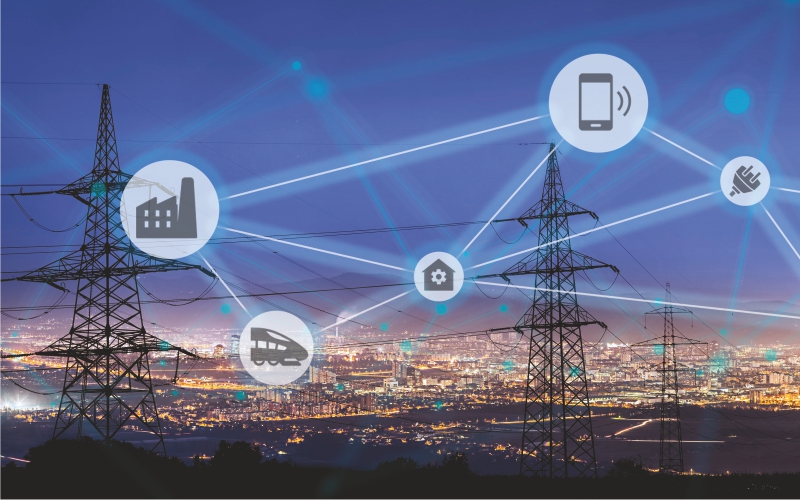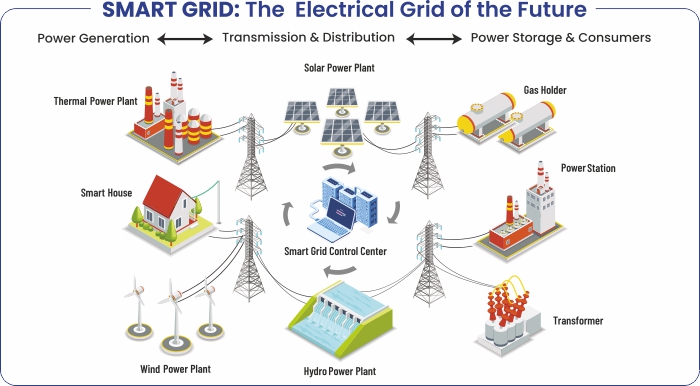Smart Grid as a term sounds flashy & fleshy, and for many a dream for the future. However, in reality, National Grid of India is becoming smarter by every waking moment of the current decade.

Smart Grid Vision for India
Electricity drives every aspect of our lives, it does not matter if urban or rural, or even the most remote area, electricity is a known term and experienced phenomenon. This omni-awareness justifies its alternative name, power. The power grid has been cited as the greatest engineering achievement of the 20th century for the power generation, transmission and distribution across the globe. The present state of the power grid in India needs to be transformed into a secure, adaptive, sustainable and digitally enabled ecosystem that provides reliable and quality energy for all.
Realizing the growing importance of transformation in the Indian power grid, the India Smart Grid Task Force (ISGTF) has been set up by Power Grid of Corporation of India Limited. ISGTF had recently submitted a report which assessed the scope of Smart Grid implementation in India, its viability, feasibility, planning, and application proposals, etc. The report was accepted by MoP under the leadership of Mr. R.K. Singh, Union Minister of Power, New & Renewable Energy, and his cabinet directed Central Electricity Authority (CEA) to design regulations and collateral framework for the implementation of the report’s findings.
The government’s initiative is laudable, but; what is Smart Grid; why India needs it; does it add to the nation’s growth and development, and if yes, then how?
Background: National Grid India
There are five broad geographic regions identified for power transmission and distribution (PT&D) in India: North, North-East, East, South, and West. Each of these regions constitutes a group of Indian states and union territories. The state-owned power corporations combine forces to maintain and oversee PT&D operations in their region. The state grids are synchronized with regional grids, which in turn are synchronized with each other to form the National Grid India, which is regulated and operated by Power Grid Corporation of India Limited. National Grid India is among the world’s largest synchronous PT&D grid networks.
Watch: RR Kabel | Solar Cables | Solar Plant | Renewable Energy
Elaborating on the grid’s functioning, the stages of power flow can be used to identify the four operational segments- power sourcing, transmission, distribution & storage.
Sourcing: National Grid India sources its power from numerous power plants set up in India, which based on their core elements can be identified as thermal (coal, lignite, gas, and diesel), hydro (large and small), renewable energy (wind, solar, biomass, and waste-to-energy), and nuclear. The grid is connected at endpoints with these plants and sources its power from electricity generated at each of the individual set-ups. The plants’ nodals which supply electricity to the grid can therefore be understood as the starting points of the National Grid India framework.
Transmission: Once infused into National Grid India, electricity, irrespective of its source, is a power supply available for the country’s consumption. However, the power infused at each source is not uniform, and it needs to be regulated before being supplied for its end uses. In order to regulate the power supply numerous power stations and substations have been constructed across the country and the same are connected through transmission infrastructure. Transmission forms the major and most important function of National Grid India, and is aided by sub-divisions of the grid; regional, state-wise, mini (sub-regions across states), micro (city-wise, or similar divisions), and nano (individual end-user).
Distribution: National Grid India’s sub-divisions help in the regulated distribution and application of power. The distribution points are used to comprehend the power demand, as they are directly connected with the end application of power. Hence, the effectiveness and efficiency of National Grid India are based on the distribution channels’ reports.
Storage: Storage grids are connected with power plants as well as transmission networks, and act as the contingency back-up of the National Grid India.
Challenges of National Grid – Drivers for Smart Grid in India
In a country as vast as India, the existence of a synchronous National Grid India is exemplary, however, once we zoom in on this web, there are certain challenges that plague it. These challenges disrupt the grid’s efficiency and effectiveness, eventually hampering smooth power supply throughout the nation.
- Integration of Rural Regions – ‘Power for All’: National Grid India is the world’s third largest electricity provider, and among the largest synchronous grid globally, however, the integration of India’s inhabited territories is still lacking, both in scope and in quality. According to Statista, in 2021, 90 percent of India’s rural areas were electrified. However, as India looks forward to becoming a USD 5 trillion economy, the integration of the remaining 10 percent is valuable, especially as the geographical vastness of India is too much for the percentage to be taken lightly.
- Peak Load Management: Electrification is a wholly different aspect than the availability of electricity. Electrification refers to the presence of PT&D infrastructure that ensures the power supply, however, the actual supply is dependent on the active availability of electricity. In June 2021, the average daily electricity supply for urban areas was 23.36 hours, and for rural areas was 22.17 hours, which represents impressive statistics. However, during the peak demand hours, many urban areas were reported to suffer at-length power cuts. The situation in rural areas is hence easily imaginable.
- Idle Captive Power Plants: Various heavy industries in India have set up captive power plants, which they use to satisfy their energy requirements. Such efforts are pro-investment and are promoted by the government through subsidies and slashed energy pricing. While the idea behind these privileges is to promote self-reliance among heavy industries, many corporations have been found using the national grid supply for their plant operations and leaving their captive plants idle, which cost them more in comparison to slashed energy rates. Integration of idle captive power plants within the National Grid can help resolve the deficiency of power supply, especially during the regional peak demand seasons.
- Unequal Electricity Distribution: India’s diverse regional and geographical conditions create a non-uniform demand across the nation. Furthermore, the peak demand seasons are also different within regions at times. This causes a strain on the supply and while the daily average for any year is impressive, the fluctuations and power cuts are a reality in various urban areas as well, let alone rural. National Grid should help identify the demand before its occurrence by accurate forecasting. The provisions could hence be made to meet the same through various sources available.
- Time Lag in Records: The PT&D structure currently records the demand, supply, and movement of power, however, this is done at intervals due to limited recording devices and technology. The real-time functioning is not activated, hence, the recording statistics are always more past than present.
- T&D And Consumer Level Losses: The T&D losses in the country exceed 20 percent. There are many factors contributing to these losses, right from transmission to end-user distribution such as obsolete infrastructure, the huge number of breakdowns, obsolete recording meters, power theft, energy let-go due to lack of storage capacity, etc.
- Renewable Energy Sources Integration: The Indian transmission segment is growing at a fast pace to support the country’s decarbonisation goals and connect 500 GW of clean energy (non-fossil fuel based) to the national grid. As the country lessens its dependency on fossil-based power, it needs to substitute the same with renewable energy.
- Theft Of Power: The lack of real-time recording and leniency in the execution of laws lead to many people, both in urban and rural areas, resorting to power theft. This leads to huge losses for the PT&D companies in the country. The real-time recording of power movement across the National Grid shall allow the companies to ascertain the areas of theft and probable perpetrators.
Relevance of Smart Grid in India
The solution which can solve all these problems in a single stroke is Smart Grid. While the stroke might be single, it is still layered, gradual, and a consolidation of various processes. National Grid India signifies the nervous system of the nation, and its optimum efficiency is inevitably important to us. Smart Grid is the tool that can ensure this efficiency.
A smart grid is an electrical grid with automation, communication and IT systems that can monitor power flows from points of generation to points of consumption (even down to the appliances level) and control the power flow or curtail the load to match generation in real time or near real time. The increased visibility, predictability, and even control of generation and demand bring flexibility to both generation and consumption and enable the utility to better integrate intermittent renewable generation and also reduce costs of peak power. If the traditional grid was made secure only through over-engineering, a smart grid is cost-effective, nimble, responsive, and better engineered for reliability and self-healing operations. The traditional electric grid will need to build additional layers of automation, communication and IT systems to transform it to a smarter grid. Smart Grid can integrate the modernized technological aspects of IoT, Machine Learning, and Data Sciences within National Grid India.

Smart Grid Roadmap for India
National Grid India is an infrastructure, but Smart Grid is an idea. Its implementation is hence a challenge. MoP’s India Smart Grid Task Force (ISGTF) has identified certain areas to implement the Smart Grid operations:
- Centralized Remote Monitoring: Smart Grid will enable IoT to allow remote monitoring, eliminating the geographical barriers caused by the remoteness of any area. Furthermore, remote monitoring coupled with surveillance shall help in minimizing the irresponsibility of the general public towards government resources.
- Operation of Substations including SCADA: Power load control is an important challenge of National Grid India. Supervisory control and data acquisition (SCADA) systems will provide controlling and monitoring systems over the active power supply. This will lead to lesser transmission losses and breakdowns, which often are a result of sudden heavy load. The restored power could be retracted into storage grids or simply reapplied to power deficiency areas.
- Flexible AC Transmission devices (FACTs): The lack or surplus of AC is a perpetrator of power gaps, power failures, fires, and other small and big accidents. FACTs in association with SCADA will provide remote control over the whole structure. This will additionally remove the need for constant, and often delayed, manual intervention for repairs and maintenance.
- Dynamic Line Loading system (DLL): The overall integrity and efficiency of National Grid India lie in its synchronous structure. Hence, the coordination framework among the different sub-grids and regions needs to be streamlined for the best results. DLL can allow the various grids across the nation to connect over shared, and secure, networks and share data information and statistics.
- Wide Area Measurement System (WAMS): Real-time monitoring is one aspect of Smart Grid that could address a whole plethora of challenges faced by the power sector of India. WAMS will help remove the current 15-minute time lag experienced across the National Grid. WAMS is also collateral to the proper application of FACTs and SCADA.
- PMUs and Data Analytics, Hybrid AC / HVDC system: Big Data is the true power of the 21st century. Special PMUs set up to oversee upgrades and new EPC across the National Grid will find these data impertinent towards planning and execution of their projects. The replacement of obsolete infrastructure or construction of new requires live and reliable data. Additionally, the data is also the feeder to technology development for new transmission systems.
Predictive Maintenance Technique using AI/ML Algorithms: Machine learning yields results for the present and a reliable base for forecasting. The statistics available post-Smart Grid integration shall be more reliable, and their trends and statistics could be relied upon to make demand-supply forecasts, and accordingly program the power flow towards and within regional grids. - HTLS Conductors: High-Temperature Low Sag, it is a conductor capable of not physically deteriorating and maintaining its transmission capabilities intact at higher temperatures than conventional conductors. Hence, the current traditional conductors shall be upgraded to the most recent advancement, such as ACCC conductors. Reconductoring projects are thus being launched in various phases across National Grid India.
Process Bus-based Protection Automation and Control GIS/Hybrid Substation: The grid-based security shall be automated for two reasons; for easier and expedited remote control, and to avoid the manpower risk due to the scientific properties of heavy power infrastructure. National Grid India, across its sub-grids, shall be developed into streamlined processes, wherein each process acts as a value addition and cross-checking of previous and subsequent processes. The manned substations shall become easily controllable and monitored, aided with the technology mentioned previously.
Cyber Security: The PT&D is a national security matter, as it shall consolidate the data which powers India’s day-to-day operations. It certainly needs to be cyber secure, for which the core is already developed. Cyber Security is not new to India, however, its integration across National Grid requires reliable manpower within the designing and implementation team, that is PMUs.
Energy Storage System: As renewable energy’s share is being hyped within the PT&D sector, its inherent fluctuations also need to be accounted for. The storage grids are hence being developed on varied levels across National Grid to save the surplus in comfortable times and ensure a uniform power supply during deficiency periods. Storage grids are also important for the optimum utilization of power generation infrastructure, which again requires huge capex investments.
Drones & Robots in Construction/Inspection of Transmission Assets: The sheer number of projects that have been identified for the expansion and upgrading of active National Grid India need to be completed within the next 5-8 years to reap the proper benefits of Smart Grid integration. Hence, technological support is required during implementation as well. The adoption of robotics and automation shall also result in higher accuracy and round-the-clock EPC project operations.
Also Read: Wire & Cable India Emagazine Mar-Apr Issue 2023
Smart Grid Milestones and Government Initiatives
The government has set up a dedicated administrative arm, National Smart Grid Mission (NSGM). The administrative office is empowered by MoP Office Memorandum dated March 27, 2015, and has been operational since 2016. The body works in tandem with India’s five-year plan structure, wherein long-term vision and mission are aligned through short and long-term objectives spanning over five years, to implement the Smart grid transformation of the National Grid India.
Phase 1: 2015-17
During the span of two fiscal years, NSGM identified five areas of development and transformation and invested INR 980 crores, wherein INR 338 crores were backed by the union budget. In this phase Smart Grids were developed for Smart Cities, microgrids were developed, training and capacity building of PT&D infrastructure was undertaken, and consumer engagement through 60 discoms’ established was achieved.
The highlight of the phase was the setting up of NSGM itself.
Phase 2: 2017-21
The targets identified for Phase 2 had been built upon the Phase 1 experience. The overall investment at the end of this phase was INR 990 crores, out of which the union budget backed INR 312 crore.
Phase 2 saw the commissioning of 10 Smart Grid projects, microgrid development in medium-sized pockets, further training and capacity building, and consumer engagement programmes through policies and tariffs.
This phase was also a witness to conscious efforts towards green energy and green efficiency through measures like EV launches.
Phase 3: 2021-24
The currently ongoing phase is continuing the 4 Smart Grid projects commissioned in Phase 2, out of which two have been completed. INR 136.95 crore has already been invested as of now, with INR 45.42 crore budgetary support.
The targets that have been identified for NSGM’s phase 3 since its establishment are:
- Stable and quality 24×7 power supply to all categories of consumers across the country
- Reduction of AT&C losses to below 10 percent in all distribution utilities
- Reduction of transmission losses (66 kV or above) to below 3 percent
- SG rollout nationwide
- Nationwide AMI roll out for all customers
- Active Participation of “Prosumers”
- Development of microgrids in 20,000 villages/industrial parks/commercial hubs
- Gas insulated EHV/HV and automated distribution substations in all urban areas by 2027
- Development of 100 smart cities
- Choice of electricity supplier (open access) to all consumers
- Renewable energy integration of 130 GW
- Dynamic (smart) energy efficiency programs nationwide
- EV charging stations in all urban areas and along all state and national highways
- Continuous research & development; training & capacity building
12 pilot Smart Grid projects have already been completed by NSGM, including IIT Kanpur Smart City Pilot, CESC Mysore, UHBVN Haryana, Smart Grid Knowledge Center Manesar, HPSEB Himachal Pradesh, UGVCL Gujarat, PED Puducherry, WBSEDCL West Bengal, APDCL Assam, TSSPDCL Telangana, and TSECL Tripura. Meanwhile, two ongoing SG projects are helmed by JVVNL Rajasthan, and CED Chandigarh.
Various government-backed schemes, such as SAUBHAGYA- Pradhan Mantri Sahaj Bijli Har Ghar Yojana (Saubhagya), Revamped Distribution Sector Scheme (RDSS), Deen Dayal Upadhyaya Gram Jyoti Yojana (DDUGJY), National Electricity Fund (NEF), Ujwal DISCOM Assurance Yojana (UDAY), have integrated NSGM’s targets into their programme layout.
Smart Grid- Boon for the Cable Industry
The transformation of National Grid India into Smart National Grid India shall require an upgrade and additions to the current PT&D structure. As is clear by the various government-backed initiatives, previously mentioned, the scope of contribution for the wires and cables industry is huge, as the base infrastructure of Smart Grid is supplied by cables and conductors.
Furthermore, Prime Minister, Mr. Narender Modi, is urging global leaders to think of “One Sun, One World, One Grid”. There are international agreements being worked upon to import and export electricity. For instance, India is in talks with the Gulf Nations for the integration of the grid for power exchange through subsea cables infrastructure. India itself is rich in renewable-based resources, and the international PT&D trade structure will open business opportunities for the Indian wires and cables industry in various new international markets.
All in all; Smart Grid can truly power India’s growth and development, not only through last-mile electrification, but across other sectors as well.




